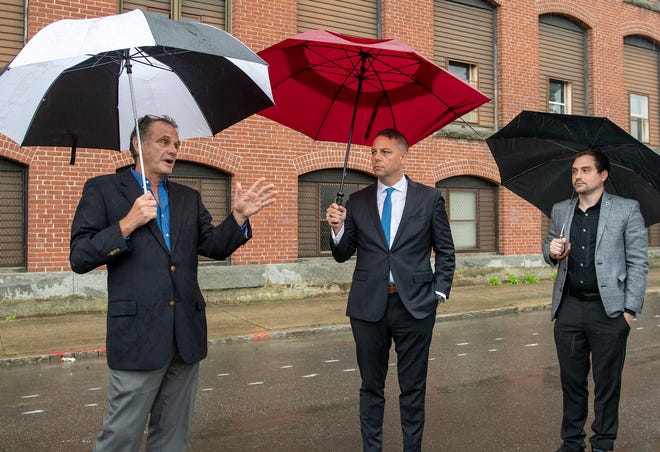
September 27, 2021
Worcester affordable housing advocates want innovation, action
BY Worcester Telegram & Gazette
WORCESTER — From two different corners of the discussion on affordable housing, Elizabeth Alfred and Kathy McSweeney offered up two startling anecdotes at a forum Friday morning.
McSweeney, president of the Realtor Association of Central Massachusetts, acknowledged there’s a housing crisis in the city.
“I’ve never seen anything like this,” she said.
She said offers from prospective buyers who participate in first-time homebuyer financing programs often go “straight to the bottom of the pile” with cash offers flying around in the city’s stratospheric housing market. The restrictive nature of the first-time homebuyer financing takes a back seat to robust offers and down payments.
“Cash is king,” McSweeney said. “Just this week I presented 15 offers for a property in Worcester.”
Alfred, an attorney with the Central West Justice Center who works with people facing eviction, said no-fault evictions are here and are on the rise, as outside investors gobble up properties, drive out existing tenants and raise rents.
Families are getting evicted from two-bedroom apartments they were renting for $900 per month and finding themselves looking for similar apartments that can’t be found for any less than $1,200 to $1,300, Alfred said.
And when that same family has to come up with first and last month’s rent and a security deposit to find another apartment they already can’t afford, it can make for a quick path to homelessness. What if you lost your apartment tomorrow? Do you have $3,600 laying around?
Affordable housing hot-button issue
It’s insane, and participants in the forum Friday, hosted by state Rep. David LeBoeuf, D-Worcester, offered reality-based perspective on steps the city, the state and the federal government could take to address affordable housing, long equated in this city with substandard housing or some sort of undesirable element.
In reality, affordable housing is more necessary than it has ever been, on a scale that municipalities and local community development corporations are simply unable to keep up with.
LeBoeuf, a member of the Joint Committee on Housing, hosted the forum Friday at the Main South Community Development Corp. He was joined by the committee chair, state Rep. Jim Arciero, D-Westford.
Main South CDC director Steve Teasdale gave attendees a rain-abbreviated tour of the CDC’s centerpiece project of the past 20 years: the Gardner-Kilby-Hammond revitalization, a truly transformative project that took a ragged mix of brownfields, substandard housing and relics of the city’s industrial past and turned it into a living, breathing neighborhood.
It’s the other district that has made a name for itself in Worcester, it’s a mix of affordable rental and owner-occupied units, and it’s not done.
Teasdale took the group down to 92 Grand St., where 48 more units of affordable housing are going up on the side of an old parking lot for one of the factories. It’s being done with union framing crews, it includes commercial space, and it should be done next year.
Teasdale said the Main South CDC’s work is ongoing, but it’s getting harder. Teasdale said materials costs have been volatile throughout the COVID-19 pandemic, with 300% increases in lumber prices delaying several projects until things cool down. And the hot real estate market means it’s getting harder and harder for CDCs like Main South to do the math to make affordable housing work.
“It’s getting harder and harder to do affordable housing on a small scale,” Teasdale said as the rain poured down onto the turf of the Clark University athletic fields, built on an old brownfield next to the new Boys & Girls Club. “When three-deckers are going for $400,000, you’re looking at $700,000 to $800,000 to buy and renovate those properties. But that’s reality if you’re going to control affordability.”
Losing control is something residents, paying exorbitant rents and competing with well-funded corporations in the real estate market, are certainly well versed in.
Nelly Medina, a community activist who lives in the Lakeside Apartments, which stretch from Lovell Street to Coes Reservoir, told the City Council last week it’s time for the city to prioritize affordable housing, and time to move away from giving wealthy corporations tax breaks to build market-rate housing city residents can’t afford to live in.
Medina said it’s time for a discussion about rent control in the city, as “landlords cash in on gentrification.”
There are programs that provide rental assistance and help for first-time homebuyers. But at the forum Friday, attendees from various city- and community-based organizations said it’s not enough.
James Brooks, the city’s Healthy Homes program manager, said more than 100 people have been qualified for assistance with the city. But they are competing in a market where sellers are getting 20 to 30 offers that include down payments of 20% to 50%. He said if they had a way to level the playing field, people might be able to break through.
McSweeney said the Realtor Association of Central Mass. supports proposed legislation that would allow residents to create 401(k)-like savings account to build up funds for home ownership.
Tenant Opportunity to Purchase Act
Andrew Howarth of Worcester Community Housing Resources said tax credits for sellers who sell to first-time homebuyers is another way to address that side of the issue. And Etel Haxhiaj, director of public housing and advocacy at Central Mass. Housing Alliance, said her organization supports the Tenant Opportunity to Purchase Act, a proposed state law that would allow tenants to purchase property and retain democratic ownership.
Haxhiaj, who is also running for the District 5 City Council seat, said over the past few months, there have been more than 200 transactions in the city in which a buyer outside the city has paid cash for property in the city.
Haxhiaj and others at the forum Friday also touched upon the environmental ramifications embedded in the housing debate. Lead remediation continues to be an issue in a city where much of its housing stock was built before lead paint was banned in the late 1970s. There were recommendations to include more flexibility in how CDCs can use state and federal funds, and state Sen. Harriette L. Chandler, D-Worcester, said it may be time to consider more innovative housing options, like the “tiny house” movement, to get roofs over peoples’ heads.
As McSweeney said, cash is king. And just as it has never been more expensive to live in Worcester, there has never been so much money flowing in that could be used to help residents. The city stands to receive close to $150 million in federal COVID-19 relief funding from the American Rescue Plan Act, and the state has about $5 billion in ARPA funds to play with.
Gov. Charlie Baker has said he wants to spend about $1 billion of the state’s cut on housing and home ownership. Local advocates have been pushing to have City Manager Edward M. Augustus Jr. follow suit and appropriate at least $22 million toward affordable housing initiatives.
Fred Taylor, business representative for carpenters union Local 336 and president of the Worcester chapter of the NAACP, said some of that ARPA money should go toward supporting CDCs and other affordable housing initiatives, including first-time homebuyer assistance and addressing homelessness.
Teasdale supported the call for the city to set aside 20% of the ARPA funds coming in to housing, but said that funding should also go toward the agencies like the state Department of Housing and Community Development to increase staffing to help push all this money out to who needs it. He said he would like to see a matching requirement for municipalities for whatever state-controlled ARPA funds are allocated.
Chandler noted during the forum that it’s time to think big about issues while the city and the state have the money. In the past, when federal funds came flowing in, communities have been caught off guard without any “shovel-ready” projects, she said.
Teasdale and the Main South CDC have weathered approaches to affordable housing that have come and gone with mixed results. But since Gardner-Kilby-Hammond, there really hasn’t been a comparably ambitious attempt at transforming a neglected neighborhood into an affordable place to live.
“It takes time, and it takes patience,” Teasdale said. “We’ve been at this 20-plus years.”
It also takes a lot of planning, effort and money, he added. He said CDCs like Main South provide proven models that have protected affordable housing in a sustainable way. They are here and are equipped to help the city address the crisis.
Juan Gomez, president and chief executive officer of Centro, said that while the city’s affordable housing stock – at around 13.5% of total units – may exceed the threshold that allows communities to be selective about affordable housing projects, but it doesn’t meet the need out there.
“Without people who work here who can afford to live here, you can’t have a functioning community,” Gomez said.
Contact Steven H. Foskett Jr. at steven.foskett@telegram.com. Follow him on Twitter at @SteveFoskettTG
